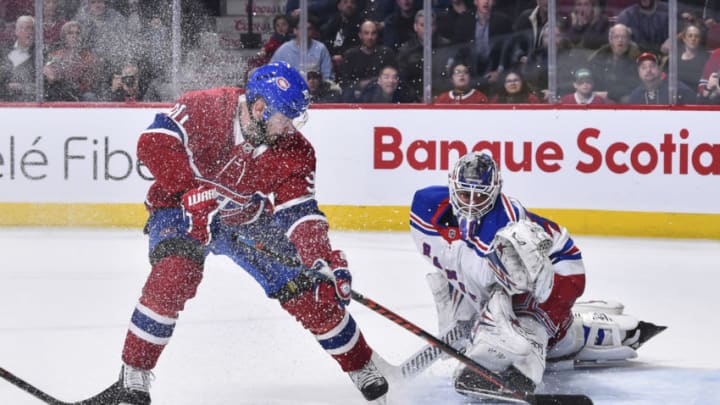Montreal Canadiens: Player salary is going to be key when it comes to trades
By Omar L

The NHL is heading into a new financial era where player salary may be more important than their cap-hit, and the Montreal Canadiens must keep that in mind.
The salary cap has had significant effects on the NHL. It’s the reason why teams can be good as long as they are and then suddenly be forced to tank and let go of key assets. Fortunately for the Montreal Canadiens, the cap hasn’t been too much of a problem, even with having Carey Price and Shea Weber to the contracts they currently have.
Some think the upcoming flat cap may change that, but if anything, it gives the Habs something else to pay attention to when it comes to player transactions.
We generally tend to focus on a player’s actual cap hit when they join an organization or receive a new deal. That is the value they contribute to the team’s overall cap dictating how close or far they are from the ceiling. But what’s going to be important moving forward is a player’s actual salary, which isn’t always the same as their cap hit.
When a player signs a deal, the yearly breakdown of the salary they obtain can be more or less each year while the cap-hit is the average money they would get over the length of the contract. Take Price, for example.
He signed an eight-year deal worth a total of $84 million. On average, that equates to $10.5 million, but the salary breakdown is different.
- Year 1: $15 million
- Year 2: $15 million
- Year 3: $9.75 million
- Year 4: $13 million
- Year 5: $7.5 million
- Year 6: $8.5 million
- Year 7: $7.5 million
- Year 8: $7.5 million
Another thing to make a note of is the difference between the money received from the team as part of the deal’s base salary vs. money received through signing bonuses. Marquee players in the NHL are beginning to take the format of having the majority of the salary attained yearly come as a signing bonus while a smaller percentage is from the team throughout the season.
A lot of it had to do with fears of an upcoming lockout to ensure they can still get money even if the NHL stops, but players are now more warm to the idea of getting a multi-million dollar check on July 1st.
Going back to Price as an example, you can see the signing bonus vs. base salary split fairly easily.
- Year 1: Signing Bonus – $13 million | Base Salary – $ 2 million
- Year 2: Signing Bonus – $13 million | Base Salary – $ 2 million
- Year 3: Signing Bonus – $8.75 million | Base Salary – $ 1 million
- Year 4: Signing Bonus – $11 million | Base Salary – $ 2 million
- Year 5: Signing Bonus – $6.75 million | Base Salary – $ 1 million
- Year 6: Signing Bonus – $6.5 million | Base Salary – $ 2 million
- Year 7: Signing Bonus – $5.5 million | Base Salary – $ 2 million
- Year 8: Signing Bonus – $5.5 million | Base Salary – $ 2 million
Teams who are trying to shed actual salary will see the structure of Price’s contract as an asset, considering he gets the majority of his money on July 1st. That said, it would be more of an attractive offer if the proposed trade was happening six years from now so the Montreal Canadiens could pick up the tab on the signing bonus.
Related Story. Darren Ferris complicates things for the Habs. light
Other organizations may be interested in a player such as Paul Byron, who has a $3.4 million cap hit but whose salary drops from $4 million to $2.8 million. There’s likely going to be some kind of compliance buyout to help teams who are cap-strapped, but the same goes for Karl Alzner as his salary drops from $4.625 million to $3 million. Interestingly enough, Tomas Tatar has a salary decrease as well, dropping to $3.083 million from $4.981 million.
These are the things that are going to be important for teams who are trying to get rid of their players who have high salaries. The Arizona Coyotes and Pittsburgh Penguins come to mind.
The Penguins and Leafs set the trade market in that Kasperi Kapanen deal. As much as it was a way for Pittsburgh to improve their top-nine while Toronto was able to add a first-round pick and a decent prospect, seeing that Kapanen’s salary drops to $2.86 million from $4 million may have been another sweetener from Jim Rutherford.
As far as the Arizona Coyotes go, Oliver Ekman-Larsson‘s salary hitting double digits at $10.5 million for the 2021-22 season may be something they want to avoid. It’s a problem for an organization like the Coyotes to afford, but a top-market team such as the Montreal Canadiens would gladly pay for that to have his services.
Next. Can the Habs afford a Laine trade?. dark
Salary and salary structure of player contracts are going to be interesting to pay attention to over the next three years. As many hockey analysts have said, because of the nature of the cap and the financial burden of the shutdown, players who weren’t available before may start to be soon. And for a team like the Montreal Canadiens, that is the sweetest sound you can conjure in today’s NHL.
Acknowledgements: Player salary and cap hits from Capfriendly